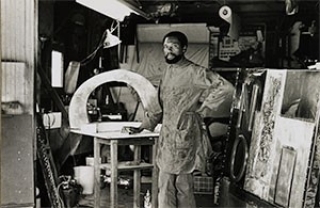Born 1933, Greenville, North Carolina
Assemblage is more than a medium for John Outterbridge; it defines a discipline of everyday living: “It seems that we all assemble notions, directives, disciplines, disappointments. We put all these things together as we seek a mode of expression and a way to live.” Outterbridge saw this aesthetic at work during his childhood in the Depression-era South, which included herbal healing pouches stitched by his grandmother and a backyard filled with objects his father salvaged from hauling jobs. In 1963, by way of a European military tour and art school in Chicago, he arrived in Los Angeles where the local junkyards, burgeoning aerospace industries, and lively contemporary art scene formed the ideal environment for him to develop his assemblage practice.
Significant work emerged in the wake of the Watts Rebellion, a six-day-long confrontation between African American residents, city police, and National Guardsmen in 1965 that left the neighborhood in ruins. From these sociopolitical experiences, Outterbridge wove together personal memories in the rags, metal parts, and found materials he used to explore broader historical themes. Case in Point meditates on the emotional impact of racism he experienced as a young adult. For this piece, Outterbridge sewed army-issued canvas into bundles that have been bound and tagged with a message highlighting the false equivalence between “packages” and “people.” Similarly, dolls in his Captive Images series, created between about 1970 and 1982, probe the conditions of enslaved people in the US. Although they recall imprisoned and corraled bodies, Outterbridge’s poetic sensibility transforms them into effigies, imbued with mysterious power. They do not succumb to bondage, but—in details like an antenna or a fabric recalling African motifs—have access to other realities.
The Captive Image dolls, early works in the Ethnic Heritage Group series, emerged from Outterbridge’s desire to teach his daughter about slavery. As cofounder and artistic director of Communicative Arts Academy (1969–1972) and director of the Watts Towers Art Center (1975–1992), he also brought his commitment to education to the larger Los Angeles community. Working alongside artist-activist Noah Purifoy, art historian Samella Lewis, and others, Outterbridge was central to increasing visibility for African American artists when galleries and museums were still marked by social exclusion.
Elaine Yau
Jones, Kellie, et al. Now Dig This! Art and Black Los Angeles, 1960–1980. Los Angeles: Hammer Museum, University of California, with DelMonico Books-Prestel, 2011.
Outterbridge, John, interviewed by Richard Cándida Smith, 1989–1990. Oral History Program, University of California, Los Angeles. African-American Artists of Los Angeles. Transcript, Charles E. Young Research Library, Department of Special Collections, UCLA.
